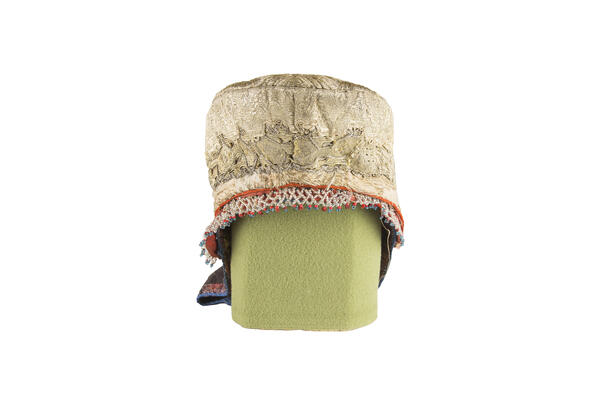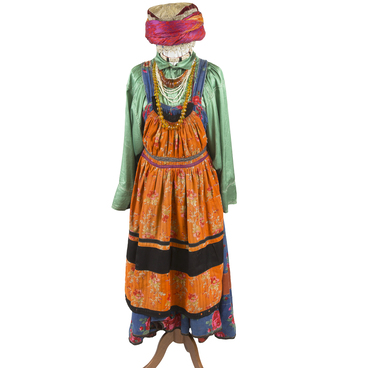The kokoshnik from the museum collection belonged to the Semeiskie of Transbaikal. The Semeiskie were a community of Old Believers and their descendants who were exiled to Transbaikalia in the 18th century by the Russian Imperial government.
The name “Semeiskie” was given to them by the locals because, unlike political exiles and convicts, who were on their own, Old Believers arrived with entire families and numerous possessions. There, they stuck together and settled in groups, forming new villages and settlements, such as Tarbagatay, Kuitun, Bolshoy Kunaley, and others.
In the Transbaikal area, the Semeiskie were mostly engaged in agriculture: they grew rye, wheat, hemp, oats, vegetables, and buckwheat. In the second half of the 19th century, when gold was found in the region, Old Believers began to work in mines.
Craftswomen were engaged in needlework, including sewing traditional Semeiskie costumes. They combined features of Polish, Ukrainian and Byelorussian dresses, and some elements were borrowed from their neighboring craftswomen, the Buryats.
The headdress of the Semeiskie women included a kichka (a type of a headdress), a kokoshnik, a pozatylnik (a piece of cloth sewn to a cardboard and used to cover hair) and a shawl. Their hair had to be covered while they were both at home and at work. On ordinary days, they wore only a headscarf, and married women also wore a kichka, which they could not take off until late in the evening.
The kokoshnik was worn only on holidays. It was made of expensive fabrics: velvet, brocade and silk. The shape echoed the outlines of the kichka. The forehead and the back parts were richly embroidered with beads, silver and gold threads. On top of the kokoshnik women tied a shawl called atlas made of satin silk or a thin cashmere shawl, so that the embroidered bottom of the headdress was visible.
Not all Old Believers wore a kokoshnik. For example, in interviews with researchers, women from Bichura — the largest Semeiskie village in Transbaikalia — mentioned that they wore only a kichka, a pozatylnik and shawl. Most likely, in the Bichursky District, they stopped wearing kokoshniks earlier than in other regions.
Since the 1930s, the traditional female headdress almost fell out of use. Until the 1960s, Semeiskie people continued to wear it to weddings, whereas on other holidays they wore only a kichka. Presently, descendants of displaced Old Believers continue to live in Transbaikalia, but only those who participate in folklore ensembles wear traditionally cut costumes.
The name “Semeiskie” was given to them by the locals because, unlike political exiles and convicts, who were on their own, Old Believers arrived with entire families and numerous possessions. There, they stuck together and settled in groups, forming new villages and settlements, such as Tarbagatay, Kuitun, Bolshoy Kunaley, and others.
In the Transbaikal area, the Semeiskie were mostly engaged in agriculture: they grew rye, wheat, hemp, oats, vegetables, and buckwheat. In the second half of the 19th century, when gold was found in the region, Old Believers began to work in mines.
Craftswomen were engaged in needlework, including sewing traditional Semeiskie costumes. They combined features of Polish, Ukrainian and Byelorussian dresses, and some elements were borrowed from their neighboring craftswomen, the Buryats.
The headdress of the Semeiskie women included a kichka (a type of a headdress), a kokoshnik, a pozatylnik (a piece of cloth sewn to a cardboard and used to cover hair) and a shawl. Their hair had to be covered while they were both at home and at work. On ordinary days, they wore only a headscarf, and married women also wore a kichka, which they could not take off until late in the evening.
The kokoshnik was worn only on holidays. It was made of expensive fabrics: velvet, brocade and silk. The shape echoed the outlines of the kichka. The forehead and the back parts were richly embroidered with beads, silver and gold threads. On top of the kokoshnik women tied a shawl called atlas made of satin silk or a thin cashmere shawl, so that the embroidered bottom of the headdress was visible.
Not all Old Believers wore a kokoshnik. For example, in interviews with researchers, women from Bichura — the largest Semeiskie village in Transbaikalia — mentioned that they wore only a kichka, a pozatylnik and shawl. Most likely, in the Bichursky District, they stopped wearing kokoshniks earlier than in other regions.
Since the 1930s, the traditional female headdress almost fell out of use. Until the 1960s, Semeiskie people continued to wear it to weddings, whereas on other holidays they wore only a kichka. Presently, descendants of displaced Old Believers continue to live in Transbaikalia, but only those who participate in folklore ensembles wear traditionally cut costumes.



